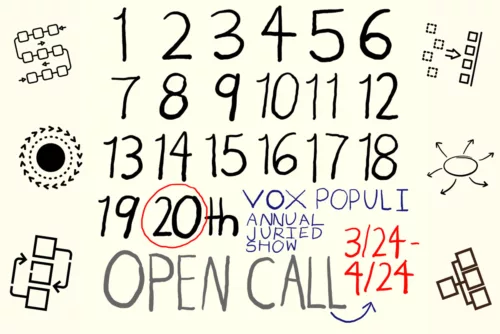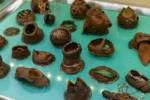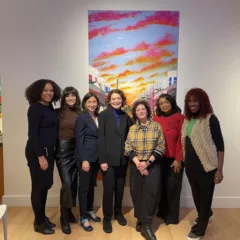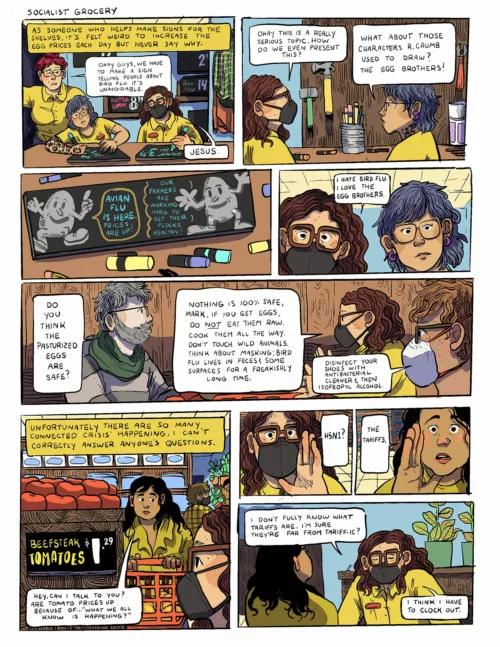Episode 304 – Strap in, art lovers! Roberta, Ryan, Anjali, and Chi pack this week with NYC museum adventures (Frick’s glittering Rembrandts, Olí Dita’s MoMA mural!), Philly Theater Week gems like Seven Funny Bits and Giovanni’s Room, plus urgent talks on trans rights and incarceration. Dive into art opportunities (Vox Populi’s jury show, PCA grants!), Dan Talley’s Albatross Project, and Roberta’s fiery debate about art vs. exploitation in Gilded Age collections. Stick around for Cecily Brown’s Barnes show buzz—and let’s keep Philly’s creative pulse racing! 🎙️🎨

Click to see the Show Links:
8th Annual Philadelphia Theater Week
GIOVANNI’S ROOM @ Quintessence
Z-CODED: Trans and Incarcerated Under Authoritarianism @ Dyke+ ArtHaus
Click to expand the podcast transcript
Roberta: Hi everyone, it’s Roberta.
Ryan: And this is Ryan and this is the midweek news on
Roberta: Artblog radio.
So should we plow into the news? Sure. Plow into the news. Okay. Alright, I’m going to start. And I’ll leave the best for last. I went, I went to New York yesterday, so I’ll, I’ll brief you on that last, but first there’s a couple of opportunities I want to talk about. Vox Populi’s annual jury show is now accepting applications.
They’re due, I believe, April 18th, but we’ll double check that date for you. And Lane Speidel who writes for Artblog is a poet and a writer, a really good writer. Is the juror this year. It costs $25 to apply, and I think you’re allowed three slides. And if you, if the application fee is a barrier, please get in touch with them because they’ll work out a negotiation with you on what you can afford.
So we’ll put in the link to that straightforward application. The annual jury show at Vox is always sort of a show. You have to see if you’re interested in art. In the alternative culture in Philadelphia, it draws from all over the country. Not only just Philadelphia, so I don’t think international, but I may be wrong about that.
They may have had international artists who heard about it. You know, because there’s the grapevine. And people do hear about things if they’re in the grapevine network. Second opportunity, there’s a Philadelphia Council on the Arts grant for craft and traditional artists. $4,000 for one year. The application is due April 14th.
It’s for folk, obviously, and craft and traditional artists in Pennsylvania, and we’ll put in the link to apply for that. And this is through the Philadelphia Folklore Project, which has been around for a good long time, and I believe they’re managing this for the Council on the Arts. Some of the previous winners for this include the West African drumming.
Core, Capra, Angola, Chinese, Peking, opera, tenango embroidery, and painting, and lots of other things like that. And there’s a phone number. We’ll put that in if you have questions and you want to get in touch with them directly. I want to mention a project that came across my inbox. The Albatross project, and of course, the albatross is this rare, endangered bird, but sort of the connotation of an albatross is something weighing you down that you is going to drag you under.
So this is an artist project by the artist Dan Talley. He’s giving away his art. So if you think about your art as an albatross, that gives you a clue to what’s going on here. He would like you to participate if you agree to give him feedback on the art that you get and live with it, at least for two weeks before you, what?
Pass it on to your children or whatever. Or maybe he wants it back. I’m not real clear on the exact details about this, but anyway, it’s an exchange. You get the art. He gets feedback from you. It seems like a real win-win to me. Oh, okay. And then now I’m down to my trip to New York. Yesterday I went with my sister who lives in New York, and we went to the Frick Collection and Museum.
Which is on 70th and Fifth Avenue. It’s Henry Clay Frick, who was the Coke king as in coal, makes Coke, makes steel from the western part of Pennsylvania. He made tons of money. He was one of the rich coal and coke barons, and he decided to do with his money. Other than the Mellons, he was very good friends with Andrew Mellon and was at one time very good friends with Andrew Carnegie.
Carnegie, as they pronounce it in Pittsburgh. They did their own things. Carnegie established libraries, public libraries around the United States. Mellon is the banking. He, they have a wonderful foundation now that gives boatloads of money to worthy organizations, including art organizations. Well.
What Frick did was he collected art and he put it in his home that he lived in on the upper floors and then opened the first two floors to people that would come in and look at the art, I guess the social elite at that time. His dates are like 1849 to 1919. Kind of Victorian, but the building itself is neoclassical.
There’s an interior courtyard with an atrium glass atrium, and all kinds of palm trees, a lemon tree that was bearing lots of juicy looking fruits when I saw it. Then in the rooms that they had laid out, which are very much Versailles like in the layout, one room after another with opulent carpets on the floor and carved.
Wood doors and all, you know, the framework and art by Rembrandt, multiple Rembrandts of Ver mirror. There’s only like 37 in the world. He’s got one of them. So he had someone that he worked with or a team of dealers that he worked with to go buy art for him, and then he put it in this. Building That was his home.
And ultimately, when he died, he gave it over to a foundation that now runs it as a museum for the public. So it’s open to the public. It’s not a city museum like the Met, which has kind of pay what you wish. So there’s a, you know, hefty fee to get in and see what’s in the house. But it’s a beautiful building.
It’s been closed for several years as they renovated it. They, for example, didn’t have a gift shop. Can you think of a museum that doesn’t have a gift shop? So now they have a really beautiful gift shop with all kinds of product based on their collection. And they also have an education department and.
And they’re going to do more education programming and all kinds of things like this. So they’ve re-upped the museum and reinstalled and dusted it off and whatever else. So that was fun. And then we went to MoMA. In the lobby of MoMA, there’s an artist we told you about this last week. Olio Dita, who’s a Philadelphia artist who has a mural that he’s putting in the lobby of MoMA, so you don’t have to buy a ticket to see it.
It’s just in the lobby, but it’s under construction right now. So I wanted to go see if he was there to say hi. He wasn’t there. But one of his artists was there, his assistants and I went up and I said, is Oly here today? And he said, no, but I know you. And I said, oh, do I know you? And it turns out he was a student of mine and Libby’s.
When we taught at Tyler School of Art in 2006, a long time ago, a senior painting studio that was the most amazing group of students we had the the best time mentoring and talking to these students and seeing what they were making and talking about their art. He has assisted O on a lot of his mural projects and so he was there.
We had a nice sort of catch-up. He’s doing well. He, being an artist like full time, had a show last August at a gallery, I don’t know the name of. Anyway, that was unexpected and very, very lovely, and that was my day in New York, plus a lot of walking. When you’re in New York, I don’t have to tell you all.
You walk and walk and walk. Wow. But it was a nice day, so that was good. Anyway, that’s my story.
Ryan: Yeah, that’s great.
Roberta: Over to you, Ryan.
Ryan: How was the what? What were the other key takeaways from that show?
Roberta: What show?
Ryan: The Frick Museum.
Roberta: Oh, the Frick.
Ryan: Well, was there a specific show or?
Roberta: No, no. They don’t do that. They built a place now that they’re going to be able to have. Con, I don’t know if it’ll be contemporary, but. Temporary shows that key off what their collection is. Okay. So they didn’t use to do that. They will be doing that. There was nothing there now. So they’re just reopening the building. So this will, you know, they’re going to reopen in stages.
I think they didn’t even have the wall labels all done for the, the works of art on the wall. So you either knew it was a Rembrandt or you did, an art test.
Ryan: So this is a soft opening kind of thing? Yes. Okay.
Roberta: Art history tour test, I guess.
Ryan: Interesting.
Anjali: So it’s kind of going to be like a Barne Foundation sort of set up?
Roberta: Kind of, yeah. But you know, I said to my sister, “Did this guy love art? Or was he just mega bucks and wanted to show art and sort of aggrandize all the wonderful artiness that you get from owning art.” I don’t know the answer to that. You won’t find that in Wikipedia. It does give you the harrowing backstory of this guy where there was an assassination attempt on his life.
He was a strike breaker. Known for this, like a really hard liner no. To labor unions. And there was a strike, the homestead strike in Pittsburgh at one of the plants, the steel plants. And they hired, and Frick was on the board of the Carnegie Steel that was called at that time. And they hired Pinkerton bad guys, like a militia, private militia to come in and they gave them rifles and there was a.
Big, horrible confrontation between the workers and the Pinkerton guys. And from that came, you know, a lot of labor churning and better things for labor unions in the long run. But in the short term, really bad. So he was known as a strike breaker, and someone that had been pro-union brought a gun in and shot him, and he survived this.
He had two gunshots to his neck and his chest, and. And he got up and he refused the anesthesia when the surgeon came to, you know, take the bullets out. Wow. I mean, he was a hard guy. Wow. Hard ass guy. Yeah. And he survived it and went on for another 20 years to lead his life and buy his art. Wow. So he had inherited money.
He came from money to begin with, so he had a headstart in life. And then he socialized with all these people that did these questionable things, like he was, have you heard of the Jonestown Flood? Jonestown is a city in Western Pennsylvania on the Ohio River, and there was a dam, I’m not sure if it was on the Ohio, but it created a small lake that was used for fishing and hunting purposes by this club that Henry Clay Frick was a founding member of.
And at a certain point, they were in charge of protecting the dam, which was an earthen dam. Not a concrete or anything, and they didn’t do a good job of that. And there was the flood, it came, it was 20 miles, the lake was 20 miles upstream from Jonestown, Johnstown, Pennsylvania. And it wiped out the town basically.
And. About 3000 people died and they whitewashed it. You know, they were good friends with people in Washington. So when it was investigated and you know, no one was charged. And I mean, there’s a checkered history to this guy. And so I thought about that once I was reconsidering the vast array of art that was there.
I don’t know that he was an art lover. Yeah, so much. I don’t know. Maybe he was, but he certainly was a treasure hunter and he has treasures in his collection and they’re worth going to see. It’s, it’s a beautiful house. Beautiful, great art. Wow. So, but kind of a mixed bag ultimately.
Ryan: So my events this week they’re a little bit theater focused because April 3rd to the 13th is the 8th Annual Philly Theater Week. A little bit later show, it’s not part of theater week, but one I do want to bring up, but one that looks really interesting is going to be seven funny bits.
It is enhanced reading for Philly Theater Week, and I love readings because they’re light and easy and you never quite know what you’re going to get. And the performances are unique. For each and every one. So this is going to be held at the Rotunda from April 1st to April 13th from seven 30 to 9:00 PM.
Rotunda’s 40th and walnut. It looks like a lot of fun, a lot of interesting readings. I do enjoy reading, so if you’re not a huge theater lover, this is a great entry point for non-theater lovers to get out and see some fun stuff. Each show is going to be different, I believe, and so there’s seven funny bits, seven different shows, and we’ll have the list of all the shows that are available and links to those co those shows coming up.
But a show that I just saw coming up in May end of May, is the James Baldwin Estate is granted Quintessence permission to produce Giovanni’s Room, which is going to be an interesting show, I imagine that’s going to be a pretty powerful show. If you haven’t read the book, this is an adaptation, it’s a theatrical adaptation to it.
Quintessence is up at 7137 Germantown Avenue. And again, that runs from May 28th to June 22nd in this political climate. I thought I would throw in one that I think is important to talk about. Dike Art House has been producing some really interesting events. They did some cozy stuff that I talked about before, which I thought was really cool and they have something talking.
It’s called Z Coated, Trans and Incarcerated Under authoritarianism. It’s really interesting, my son is going to college and so he just got his Selective Service document from the federal government, which I think is ironic. Who knows if Selective Service is going to exist? But anyway, it’s just a standard form that says if there’s a draft, you have to be in it.
And it’s really interesting because there is a trans out option which requires you to out yourself and to document it and provide in the form. And I thought that was really interesting. And I don’t think that was a Trump era document, I think as you know, precursor to that. But I thought it was really interesting that.
You’re, you’re welcome to out yourself to the federal government. How exciting if you’re not out already, but so I think this is really important now and tomorrow. And yesterday as well. So this is again called Z Coded Trans and Incarcerated Under Authoritarianism. This is Friday, April 11th. There’s an exhibit and then it will be a panel discussion as well.
Those are my quick three for the week. I’ll have links to the 8th Annual Philly Theater Week major link to show you the different things that are happening for the 10 day span. 10, 11 different days of shows. Things will come slightly before, a little bit after, but most of that will happen during that week.
Those are my big ones, and I’m putting together a list of. For next week will be newsletters you should sign up for, because people keep sending me really interesting newsletters. I’m like, oh, I should make change my newsletter and make it different. And
Roberta: that’s very useful, Ryan. I think so too.
Ryan: I think so too.
People could utilize that. So I’m putting together a list of newsletters, really specific or fun in general, and I’ll categorize them and then. I’ll put them in the podcast and I’ll make a little, a little post for them too so you can find them.
Roberta: Can I ask about the play readings of the Rotunda? Yeah. For those that don’t know how play reading works, yeah.
I’ve never been to one.
Chi: Yeah.
Roberta: Are there actors from the plays that are going to be sitting at a table reading from the script, or how does it work?
Ryan: So it depends. In this case, I believe what’s happening is. These are play readings to get feedback and to talk about what people would like to see for fringe.
So fringe comes up late summer, early fall. And so I think some of these are like pre fringe. Shows that that they will want to get some feedback for and sharpen a little bit of the writing and the performance. Sometimes it’s just like a fundraiser for a theater company, so they’ll just pick a play that they’re not actually going to perform and they’re just reading it.
So you come and pay x, y, z dollars and because it’s just them performing, there’s no crew and there’s no per no staging. It’s just them with a. Their scripts. It’s usually a low cost, low having, they’re just riffing with each other. Kinda like if it was just jazz musicians just like came up on stage and just started playing something.
It’s closer to that sort of relationship where there’s a script, there’s some sort of baseline music, but they’re just kind of going with it as well. Whatever happens, there’s no necessarily rehearsal for the performances. They’re just kind of performing alive, and it’ll never look the same again. And it might just be that one off event.
Roberta: Is it usual?
Ryan: And this is funny, so I assume they’re going to be comedic. I don’t know anything about the works and so it’s a bit of a wild card, but it’s also going to be an easy entrance, a low cost of experiencing, and you don’t quite know what you’re going to get, but it could be fun. So those are my three.
Roberta: Alright.
Ryan: Yeah.
Roberta: How about angel and she. You have any updates you want to share with us?
Anjali: Yeah. Well first of all I think as people have seen on our Instagram, we visited the press preview of the Cecily Brown themes and variations of the Barnes. And I just wanted to kind of plug again that people should go visit that.
because I think it’s a really, really great show that shows like the evolution of Cecily Brown as an artist. And that exhibit closes on May 25th. So just wanted to plug that again. And then me and she are actually going to a showing of E two Mama, Tom Bien at the Philadelphia Film Society tonight. So that’s really exciting.
And there’s going to be a q and a with a professor from Penn that wrote a book about the film. So we will report back about that. And that’s pretty much it for me. That’s
Ryan: great. Have you seen the film before?
Anjali: I saw it like a while ago, so I feel like I’ll have a new appreciation for it now. For sure.
Chi: I haven’t seen the show, so kind of excited to also meet.
The programmer. So in the Film Society Philadelphia Film Society, and to know the organization, how the, the program works there. So yeah, pretty excited.
Roberta: I want to say. I’m glad you brought up the Cecily Brown Show because we have. A review in the works that will be on Artblog in another week or so.
Great.
Ryan: Anything else?
Roberta: No, that’s about it for me.
Ryan: That’s it for me.
Roberta: Thank you everybody for listening. It’s Roberta saying bye-bye. See you next time.
Ryan: And this is Ryan. This has been Artblog’s Midweek News.
Anjali: This is Angeli. Thank you so much.
Chi: This is Chi thanks for keeping up with the Artblog.
Ryan: Thanks everyone. See you next time.
Meet Our Hosts











